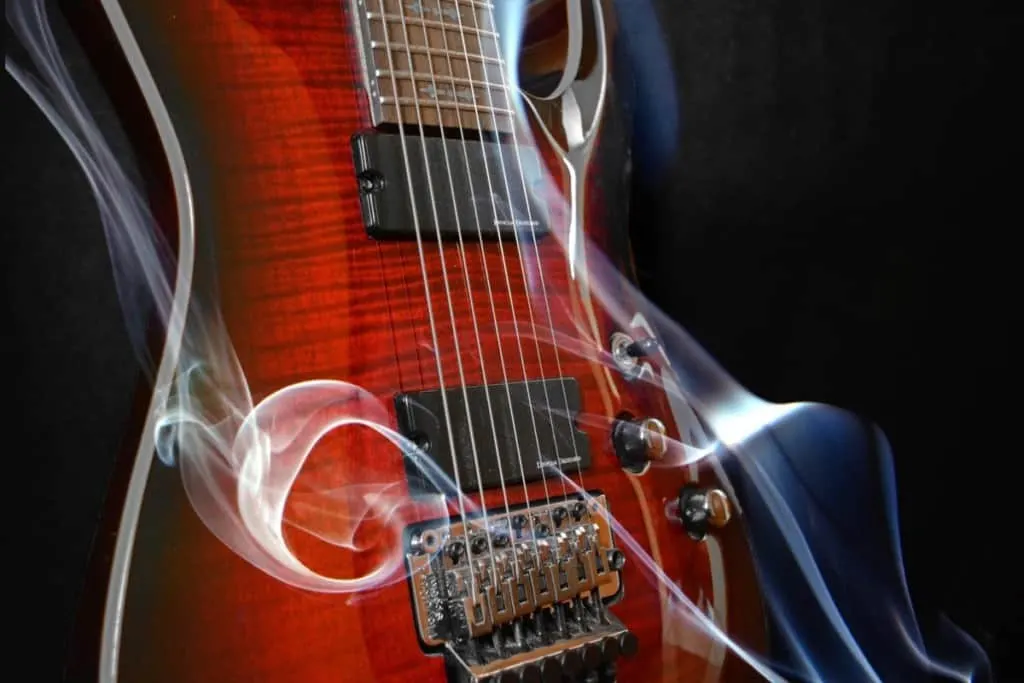Getting radio interference in your guitar amplifier is among the top 3 “most annoying moments with your instrument”. It really is one of those moments that you say: there is no possible way on earth that I can play like this.
So, why do guitar amps pick up radio?
The fact that some guitar amplifiers pick up the interference and some don’t is because of shielding and grounding. Guitar amps pick up radio interference for the simple reason that an AM receiver is only a diode and a resistor and you have plenty of those components inside an amplifier.

With the proper shielding and grounding on guitar, amp, and cable, the frequencies floating in the air can’t get in, and hence, you can’t hear them through the speakers.
If shielding or grounding fails in any of them and you live close to an AM antenna, you will very likely have the meteorologist tell you about the weather in the middle of your wailing guitar solo (which is innovational, to say the least).
Just know, you are not alone in having his problem! Take a look at this video, then check out the troubleshooting guide below.
The Ultimate Troubleshooting Guide To Follow
Ok, here’s the deal. When we face this kind of issue, what we have to identify is where it’s coming from. Back in the early days before making a thorough investment and finally isolating the entire studio, I came up with this “ultimate radio pick up troubleshooting guide”.
It’s simply a process of elimination.
Let’s go straight to it:
1. The first step is to unplug everything and keep the amplifier on. If the radio is still there, then it is the amp. In order to solve it, we need to move it around and place it facing different cardinal points. Also, check the grounding.
2. If the amplifier is quiet, it is time to look at the cable going to and from the amp. Leave the cable plugged into the amplifier and stay away from touching the tip (that way you’ll avoid that awful noise). If the radio interference is still coming out of the speaker with no instrument plugged in, you need to swap that cable out for a shielded one.
3. If there are pedals in between the amp and the instrument, you have to initially remove them and, if the interference is still there, then it wasn’t them. You are going to have to plug the pedals in one by one to check which one is causing it. Sometimes it is the AC adapter, so running them on batteries for recording sometimes solves the issue.
4. The final step of the troubleshooting guide is the instrument. Try moving it around and face it in different directions to try and get that interference out. If you can’t achieve it doing that, simply swap the instrument out. The more instruments you have with a Faraday Cage (more on this later), the more likely you’ll leave the radio presenters out of your future recordings.
I guess we have all been there; that moment that everything is properly connected and you are just about to hit the first note and the loud masculine voice comes out of the speaker advertising moisturizing cream for your facial problems. A complete bummer. Guitar amps pick up radio interference; that is a fact. Hopefully, this troubleshooting guide will help.
So, that’s the bad news. The good news is that there are many ways you can solve this problem and most of them are not expensive at all. Read on; understand why guitar amps pick up radio interference, and how to stop it before it even starts.

Reasons Why Your Guitar Amplifier Picks Up Radio Interference
This phenomenon has been happening ever since there were guitar amps put in this world.
Let me tell you a little story. Once I was a young man with a dream, I decided to build my own home studio to do recordings. Yes, I was, by all means, repeating the dream of my generation. Computers and audio interfaces made it possible to bypass big recording studios I never had the money for.
With a medium investment, I could just make my own records at home. It was going to be a blast, no doubts about it.
After finishing the architectural endeavor of panels and such, it was time to start recording.
My big mixer ready, gleaming new cables, a valve-driven Fender Bassman miked up and ready to go and facial cream advertising coming loud and clear from the radio station through my amplifier! It was one of those moments I will never forget.
We finally got rid of the interference and had an amazing recording session which paved the way for many more to come, but let’s say that I have dealt with radio interference many times before in my life and managed to solve it too.
Let’s go through the main two reasons why the interference is there in the first place and then how to solve it on the spot (or with some infrastructural investment).
Shielding A Guitar To Prevent Radio Transmissions
Shielding is a very common thing to do on audio equipment.
In fact, most of the high-end instruments designed to share the stage with a million-dollar PA and two-million-dollar light schemes have to be shielded to prevent static too.
Shielding is not a subatomic thing that will require a NASA suit and pliers to handle radioactive equipment, it is simply to put some extra metal paper to your guitar so it won’t be so conductive to pick up outside noise.
Some brands already do this, and you get the guitar with shielding in the cavity from the factory.
For example, instruments for the professional, gigging, or session musician, like the Fender American Ultra already have this treatment on the guitars and basses.
The aim of this shielding is to prevent outside noises by achieving an isolation system known as Faraday Cage. It was invented in 1836 by Michael Faraday and is still broadly used today in all kinds of endeavors, including high-tech in most of the most important universities in the world. If your guitar does not have the proper shielding, let’s take a look at how it’s done.
How To Eliminate Radio Interference In A Guitar Amplifier
The first step to solving radio interference from a guitar (or bass) point of view is to remove the pickguard and see if there is any kind of aluminum or copper tape attached to it. You are going to have to create the Faraday cage by simply covering the entire cavity with either aluminum tape or copper tape. In the video below, you can clearly see how it’s done, what you need, and the result.
On the other hand, it is important that you take good care of your cables as well. There are some cables out there that are shielded and some that are not. You should make sure you are using shielded cables exclusively. Cables with the proper shielding do not pick up any interference between the TRS ends and conduct your signal from end to end perfectly.
Take a look here at the massive selection of shielded guitar cables available on Amazon.
Grounding A Guitar To Stop Radio Interference
As we saw what to do when it comes to guitars, basses, and cables, it is time to take a look at the guitar amp itself. Of course, you can do shielding inside an amp to create its own Faraday Cage as well, but that is far from being a DIY project, you´ll need to take the amp to a technician and have them do it for you. What you can and should check with your amplifier is that it is correctly grounded.
A grounded amp is not one that misbehaves, and we are sending it to the corner, it is actually an amp that has protection against the radio emissions and is also safer in terms of electric shock. You can find a logo in the shape of a down arrow when looking at the circuit diagram in most appliances and amps. To explain it clearly, let´s take a look at your amplifier parts.
· Preamp section
· Power amp section
The preamp section is the first thing that your guitar signal comes across with.
This part of your amplifiers handles way lower voltage than your power amp section because it doesn’t amplify the signal, but shapes and colors it (equalizers and such).
Now, after coloring, the signal goes to your power amp section, gets amplified according to the volume you desire, and then goes to the speakers. Pretty simple, right?
The power amp section is in connection with the preamp but handles way more current or electric power that goes to the transformers that actually amplify the signal. So, the grounding works as an outlet so the extra current handled by the power amp will not go back into the preamp section to create noise and interference, but out to the ground.
How To Stop A Guitar Amplifier Picking Up Radio
To solve an amplifier picking up the radio the first thing you need to do is to move it from one place to another and rotate it until you find it is no longer picking up any noise.
Second, look for the down arrow in the circuit diagram and the third leg that goes into the socket (if you live in the US that is where the green cable goes).
If you can’t find the ground using those methods, it is time to go for a technician and try to have him or her check your amp and add that ground to it.
Also, make sure that your house or studio is grounded, especially the socket where amps are plugged in. Finally, make sure you are not plugging any lights in the same socket as the amplifier as that can bring more noise to the signal.
The way I solved it once and for all was burying down a metal cage around it and using it as grounding. It cost me a lot of money, but everything inside my studio is dead-quiet.
Conclusion
Luckily for you, there are players like me willing to give out all their secrets just for the sake of helping others avoid what we have been through. Follow these tips and always have the phone number of a technician ready to take care of what DIY can’t reach.
Happy (noise-free) playing!
